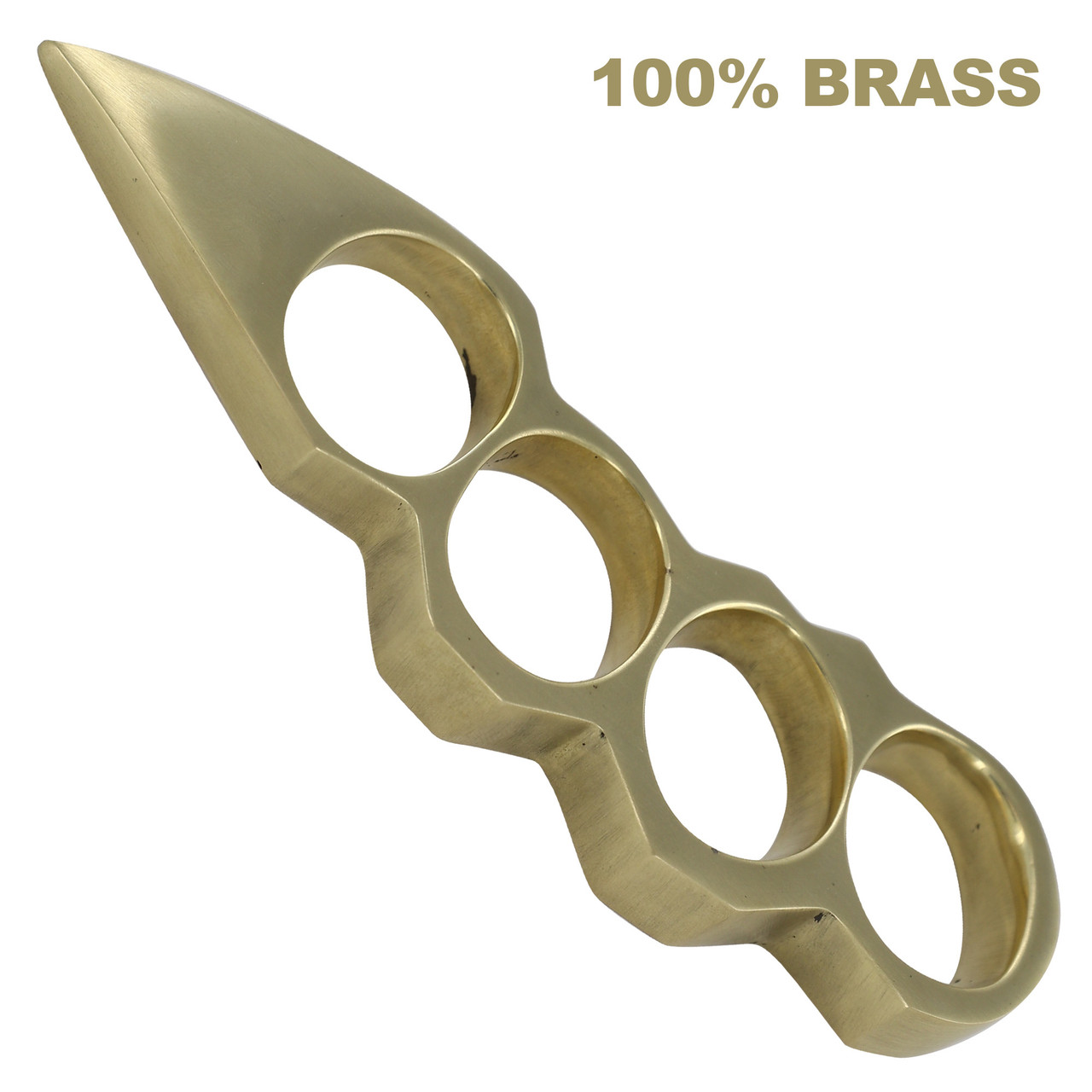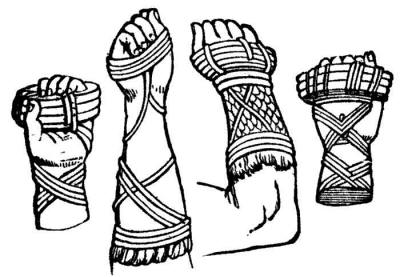Examining the Use of Brass Knuckles in Medieval Society
Posted by Swordsswords on Mar 4th 2024
Today, brass knuckles pack a potent punch on the streets, their metallic gleam synonymous with back-alley brawls and concealed weapons. But did these knuckle duster have a place in the rough-and-tumble world of medieval society? Did knights conceal them beneath their gauntlets, or did rogues rely on them for self defense in shadowy taverns?
Today, we delve into the murky depths of medieval combat to uncover the truth about knuckle – were they a prevalent tool of violence, or a myth born from Hollywood's fight scenes?
We will examine the evidence, debunk the myths, and reveal the surprising reality of real brass knuckle in medieval times.

The Form and Fury of Knuckle Through Time
Before we travel back in time, let's arm ourselves with knowledge about the weapons itself. Knuckle duster might have a metallic name, but throughout history, they've been crafted from diverse materials like:
- Wood: Lighter and readily available, offering basic protection.
- Bone: Durable and readily available, sometimes decorated with carvings.
- Iron: Heavy and sturdy, inflicting significant damage but potentially weighing down the hand.
- Hardened Leather: Flexible and concealable, offering some protection but prone to wear and tear.
The core design, however, remains similar: a rigid ring or plate with finger holes, worn over the belt buckle to amplify a punch's impact. If you want to concentrate the force of a bare fist onto a smaller, harder surface, consider buying two finger brass knuckles for more brutal efficiency.
- Impact: Channels the blow's energy, bypassing flesh and bone, directly transferring it to the target.
- Damage: Nasty fractures, deep tissue damage, significantly worse than a bare fist.
However, variety also exists:
- Simpler designs: Fingerless rings offering basic protection.
- Elaborate forms: Multiple finger loops, spikes for maximum damage.
- Hidden blades: Some cultures incorporated blades for deadliness.
However, pinpointing the specific types and materials used in the medieval period remains a challenge. Unlike swords or armor, brass knuckles rarely leave clear archaeological traces. Fragmented texts and artistic depictions have become our puzzle pieces.
Hunting for Brass Knuckle: Evidence in Medieval Shadows
The hunt for concrete evidence of brass knuckles in the medieval world proves frustratingly elusive. Unlike the gleaming swords and ornate armor that grace museums, these fist-fortifying tools rarely left behind lasting traces. Archaeological digs yield precious little, leaving historians to piece together a puzzle from scattered fragments.
The Archaeology Void: Unfortunately, these weapons were often crafted from perishable materials like wood or leather, quickly succumbing to time and decay. Even metal versions might have been hidden, reused, or melted down, leaving no trace for eager archaeologists.
But fear not, fellow history sleuths! Though direct evidence remains scarce, we can turn to other sources to illuminate the shadows:
1. Art and Literature: Through a Skeptical Lens: Medieval tapestries and manuscripts sometimes depict fist-fighting scenes. While artistic license often reigns supreme, some details might hint at the use of finger-protecting implements. However, caution is crucial. A raised fist in a brawl doesn't guarantee a hidden knuckle duster!
2. Legal Codes and Records: Whispers of Similar Weapons: Legal documents from the era, though not explicitly mentioning brass knuckles, might offer clues. References to banned "unfair" fighting techniques or weapons designed to inflict specific injuries could point towards the existence of knuckle enhancing tools.
3. Global Comparisons: Borrowing Clues from Across Cultures: History rarely unfolds in isolation. Examining documented use of brass knuckles in other cultures and time periods, like ancient Rome or later Asia, can offer valuable insights. Were similar weapons known in neighboring regions? Could knowledge or trade have brought them to medieval Europe?
By carefully analyzing art, legal records, and cross-cultural comparisons, we can build a more nuanced picture of the potential presence and use of brass knuckles in the medieval world. It's a detective story without a smoking gun!
Potential Uses of Brass Knuckles in Medieval Mayhem
While definitive proof of widespread brass knuckle use in medieval times remains elusive, speculating on possible scenarios where they might have been employed can be an intriguing thought experiment. Imagine these fist-fortifying tools gracing (or disgracing) the medieval world:
1. Self Defense: In a society rife with violence and limited legal recourse, the ability to inflict quick, debilitating damage could be seen as a necessary tool for self defense . Merchants traveling treacherous trade routes, or women facing harassment, might have found these concealed weapons empowering.
2. Brawls and Tavern Scuffles: The heat of the moment in a crowded tavern brawl could lead to desperate measures. A hidden brass knuckle might offer an unfair advantage in a drunken fistfight, settling scores with brutal efficiency. However, remember, such use could also invite legal repercussions or social ostracization.
3. Specific Combat Styles: While knights in shining armor wouldn't likely resort to such underhanded tactics, certain fringe combat styles or underground fighting techniques might have incorporated knuckle-strengthening tools. Imagine gladiatorial-inspired spectacles or brutal mercenary tactics where pure brass knuckles offered a hidden edge.
4. Concealed Weapon for Assassination: The ease of concealment could make brass knuckles appealing for stealthy attacks. Imagine cunning spies or assassins using them to strike silently and eliminate their targets with a single, devastating blow. However, their effectiveness against armor remains debatable.

Debunking Brass Knuckle Myths in Medieval Society
Knuckle duster, often painted as ubiquitous tools of medieval mayhem in modern fiction, carry a hefty baggage of misconceptions. It's time to separate historical fact from cinematic fantasy and debunk some common myths:
Myth #1: Every Knight Packed a Punch: Picture a noble knight, clad in shining armor, discreetly concealing a brass knuckle. While the image might have cinematic appeal, it lacks historical basis. Knights adhered to specific codes of honor and primarily used swords, lances, and other approved weapons. The covert, brutal nature of brass knuckles wouldn't align with their fighting style or code of conduct.
Myth #2: Criminals' Fist of Choice: While violence in medieval society was a reality, associating brass knuckles solely with criminals is misleading. The scarcity of concrete evidence makes it difficult to pinpoint who might have used them, if at all. Blaming a specific social group perpetuates harmful stereotypes and ignores the complexities of the period.
Myth #3: Widespread and Openly Used: Hollywood often depicts brass knuckles as readily available and used in open combat. However, remember the lack of archaeological evidence. Their concealable nature might have led to discreet use, if any, and widespread adoption is highly unlikely given the materials and potential legal implications.
Myth #4: The "Medieval Brass Knuckle": Don't get fooled by fictionalized depictions of ornately designed, brass-plated weapons. While the term "brass knuckles" might evoke metallic imagery, remember their diverse materials throughout history. Wood, bone, and even hardened leather were more likely options, adapted to the available resources and cultural context.
So, why debunk these myths? It's crucial to rely on historical evidence, not romanticized portrayals, to understand the past accurately. Brass knuckles might have existed in medieval times, but their presence, use, and social context remain largely speculative. By dispelling misconceptions, we foster a more nuanced appreciation of the complexities of medieval society and avoid perpetuating inaccurate stereotypes.
Also check this blog for hunting knives: The Best Hunting Knives Under 12 You Can Buy Right Now
Brass Knuckles in Medieval Society
Our foray into the shadows of medieval combat reveals a fascinating, yet inconclusive, picture of brass knuckles . While direct evidence remains elusive, potential uses in self defense, brawls, or clandestine attacks paint intriguing possibilities. However, debunking common myths like widespread knightly use or criminal association underscores the importance of historical accuracy.
The limitations of available evidence leave much to the imagination, but they also ignite the fires of further research. Could advancements in archaeology or historical analysis unlock new pieces of the puzzle? Were there regional variations in their use? Perhaps forgotten texts or artistic depictions hold hidden clues. Also check the swordsswords collection of brass knuckles for sale. They are offering affordable and high quality options.

